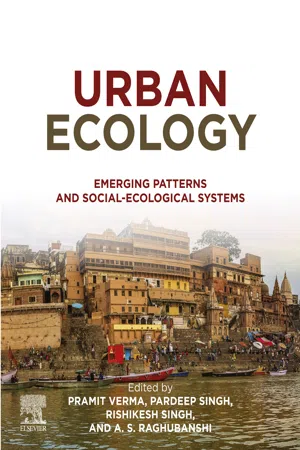
Urban Ecology
Emerging Patterns and Social-Ecological Systems
- 532 pages
- English
- ePUB (mobile friendly)
- Available on iOS & Android
Urban Ecology
Emerging Patterns and Social-Ecological Systems
About this book
Urban Ecology covers the latest theoretical and applied concepts in urban ecological research. This book covers the key environmental issues of urban ecosystems as well as the human-centric issues, particularly those of governance, economics, sociology and human health. The goal of Urban Ecology is to challenge readers' thinking around urban ecology from a resource-based approach to a holistic and applied field for sustainable development. There are seven major themes of the book: emerging urban concepts and urbanization, land use/land cover change, urban social-ecological systems, urban environment, urban material balance, smart, healthy and sustainable cities and sustainable urban design. Within each section, key concepts such as monitoring the urbanization phenomena, land use cover, urban soil fluxes, urban metabolism, pollution and human health and sustainable cities are covered. Urban Ecology serves as a comprehensive and advanced book for students, researchers, practitioners and policymakers in urban ecology and urban environmental research, planning and practice.- Includes global case studies from over 14 countries, providing a first-hand account of recent applications- Covers the phenomena of sustainable transport, nutrient recovery and human health, among many others- Examines environmental issues as well as social-ecological systems and governance
Frequently asked questions
- Essential is ideal for learners and professionals who enjoy exploring a wide range of subjects. Access the Essential Library with 800,000+ trusted titles and best-sellers across business, personal growth, and the humanities. Includes unlimited reading time and Standard Read Aloud voice.
- Complete: Perfect for advanced learners and researchers needing full, unrestricted access. Unlock 1.4M+ books across hundreds of subjects, including academic and specialized titles. The Complete Plan also includes advanced features like Premium Read Aloud and Research Assistant.
Please note we cannot support devices running on iOS 13 and Android 7 or earlier. Learn more about using the app.
Information
Chapter 20: Towards sustainable urban redevelopment: urban design informed by morphological patterns and ecologies of informal settlements
Abstract
Keywords
1. Introduction
1.1. Informal settlements in the global
Table of contents
- Cover image
- Title page
- Table of Contents
- Copyright
- Contributors
- Foreword
- List of reviewers
- Theme I. Emerging facets of urban ecology ̶ urban and urbanization, theory and concepts
- Theme II. Urban land use land cover
- Theme III. Social ecological systems
- Theme IV. Urban environment
- Theme V. Urban material balance
- Theme VI. Cities: healthy, smart and sustainable
- Theme VII. Sustainable urban design
- Index